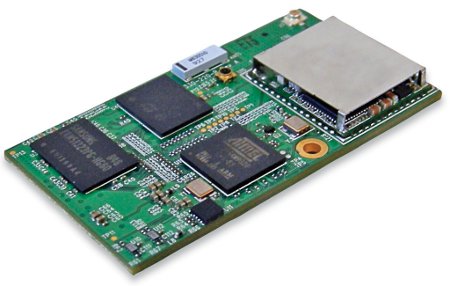Linux-based Wi-Fi device server offers dual-band support
Feb 10, 2011 — by Eric Brown — from the LinuxDevices Archive — 2 viewsLantronix announced a Linux-based wireless device server with IPv6 and extended temperature support. The PremierWave EN is built on a 400MHz Lantronix ARM9 processor, offers 64MB of RAM and 64MB of flash, provides dual-band 802.11a/b/g/n with extensive wireless security features, and includes USB, Ethernet, I2C, SPI, and serial connectivity.
Lantronix has long offered a line of MatchPort embedded device servers, including last year's MatchPort NR. While the Matchport modules ship with tools that allow them to be configured by Linux or Windows, they do not run on embedded Linux, as does Lantronix' tiny, XPort Pro networking server. Rather the MatchPort devices use the company's own "Evolution OS" device-server oriented operating system, and act as dedicated co-processor serial device servers.
While the PremierWave EN is also intended to be embedded into another device, it operates as a standalone, Linux-based embedded device server, and also adds secure Wi-Fi networking support in addition to the Ethernet support offered by the MatchPort. The module allows design engineers and original equipment manufacturers (OEMs) "to easily add intelligent, wireless Ethernet networking to any device," says Lantronix.

Lantronix PremierWave EN
(Click to enlarge)
The PremierWave EN is built on a dedicated 32-bit ARM9 processor clocked to 400MHz, says the company. However, judging from the photo, this appears to be an Atmel SAM9G20. The module is further equipped with 64MB of SDRAM and 64MB of flash memory, says the company.
The main course here is the dual-band (2.4GHz and 5GHz) 802.11a/b/g/n modem. The Wi-Fi modem ships with onboard antenna and supports security standards including AES, SSL, TLS, and SSH, says Lantronix.
The module's serial interface includes dual serial ports, a full-speed USB 2.0 host and device connection, and a high-speed SPI interface, says the company. Additional interfaces are said to include Ethernet and I2C. The PremierWave EN is said to support operating temperatures of -40 to 185 deg. F (-40 to 85 deg. C) and consume 515mA at 3.3 Volts, or 284mA on standby.
The PremierWave EN's networking firmware includes network load balancing and traffic segmentation, says the company. Meanwhile, a VIP Access feature is said to ensure secure remote access to equipment, even if it is located behind a corporate firewall.
The module offers a novel feature that scans access points for signal strength, authentication, and encryption types, and then displays the results on a web page, says Lantronix. This is said to enable remote technicians to diagnose problems as they occur, and to troubleshoot over any IP network without a service call.
Stated Martin Poppelaars, regional director for EMEA at Lantronix, "Initially we expect to see the medical sector really embrace our new wireless device server as the missing piece of the puzzle, as it removes complexity from these otherwise intricate and often multifaceted systems. The flat and compact design makes it appealing to all markets across Europe, and will play a key role for the abundance of businesses looking to make remote management a reality this year."
Availability
No pricing or availability information was offered for the PremierWave EN, but the quote above strongly suggests it's heading for Europe. More information, including a full spec list, may be found at the Lantronix PremierWave EN page.
This article was originally published on LinuxDevices.com and has been donated to the open source community by QuinStreet Inc. Please visit LinuxToday.com for up-to-date news and articles about Linux and open source.